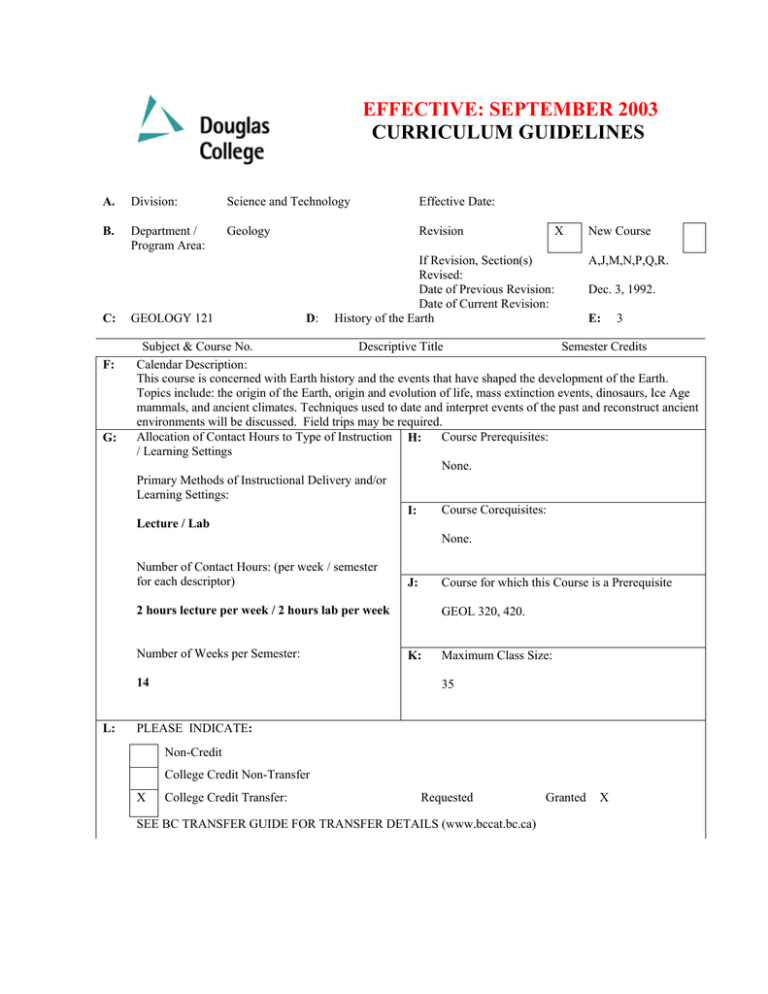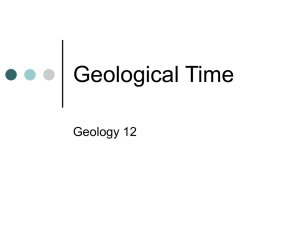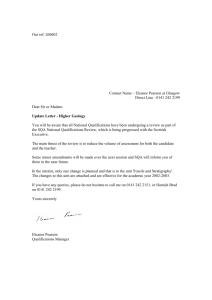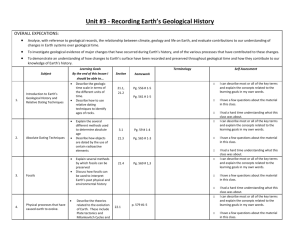
EFFECTIVE: SEPTEMBER 2003
CURRICULUM GUIDELINES
A.
Division:
Science and Technology
Effective Date:
B.
Department /
Program Area:
Geology
Revision
C:
F:
G:
GEOLOGY 121
D:
If Revision, Section(s)
Revised:
Date of Previous Revision:
Date of Current Revision:
History of the Earth
New Course
A,J,M,N,P,Q,R.
Dec. 3, 1992.
E:
3
Subject & Course No.
Descriptive Title
Semester Credits
Calendar Description:
This course is concerned with Earth history and the events that have shaped the development of the Earth.
Topics include: the origin of the Earth, origin and evolution of life, mass extinction events, dinosaurs, Ice Age
mammals, and ancient climates. Techniques used to date and interpret events of the past and reconstruct ancient
environments will be discussed. Field trips may be required.
Allocation of Contact Hours to Type of Instruction H:
Course Prerequisites:
/ Learning Settings
None.
Primary Methods of Instructional Delivery and/or
Learning Settings:
Course Corequisites:
I:
Lecture / Lab
None.
Number of Contact Hours: (per week / semester
for each descriptor)
Course for which this Course is a Prerequisite
J:
2 hours lecture per week / 2 hours lab per week
Number of Weeks per Semester:
14
L:
X
GEOL 320, 420.
K:
Maximum Class Size:
35
PLEASE INDICATE:
Non-Credit
College Credit Non-Transfer
X
College Credit Transfer:
Requested
SEE BC TRANSFER GUIDE FOR TRANSFER DETAILS (www.bccat.bc.ca)
Granted
X
Page 2 of 4
M:
Course Objectives / Learning Outcomes
A.
Geology as a Science
1.
Understanding the nature of science and its strategies
2.
Understanding of the difference between experimental and historical (interpretive) sciences
3.
Development of critical thinking skills in assessing evidence and interpretations
4.
Understanding of the role of time perspective in geological investigations: time as the fourth
dimension
5.
Understanding of the cumulative nature of history: that each outcome provides the initial
conditions for the next
6.
Understanding of the development, nature, and implications of Uniformitarian theory and
differences from Catastrophism
7.
Understanding the place of geology vis-B-vis other disciplines
B.
Time Perspective and Context
1.
Knowing “by heart” the geological time scale in terms of eons, eras, periods, and Cenozoic
epochs
2.
Knowing the history of important events and people involved in the development of the
geological time scale
3.
Knowledge of the character and overall historical context of the solar system
C.
Stratigraphy
1.
Knowing the underlying principles of stratigraphy as applied to sedimentary successions
(relative dating)
2.
Understanding of the origins of sedimentary rocks and of stratified and cross-cutting igneous
rocks
3.
Understanding of the Principle of Fossil Succession
4.
Knowing how the stratigraphic and fossil records served as the basis for an understanding of
geological time (relative)
5.
Understanding of the facies concept as applied to both rocks (sediments) and fossils
6.
Understanding of the potential and procedures of paleoecological/paloenvironmental analyses
7.
Understanding of the role of analogy (use of modern analogues) in paleoenvironmental work,
and limitations thereof
D.
Fossils
1.
Familiarity with the major kingdoms and of the phyla of organisms typically encountered in
the fossil record
2.
Knowing how to identify examples of all these phyla, including a basic suite of fossils at the
genus level
3.
Development of skills in observation of diagnostic criteria as a basis for fossil identification
4.
Development of ability to distinguish fossils from common “pseudo-fossils” (e.g., dendrites)
5.
Understanding of principles of evolution and extinction
6.
Familiarity with the overall paleontological sequence, evolutionary changes, and key
examples such as the dinosaurs and Ice Age mammals.
E.
Landscapes
1.
Understanding how modern landscapes are indicators of past conditions
2.
Understanding of unconformities in the stratigraphic sequence as paleolandscapes
F.
Sequences and Correlation
1.
Understanding of the development, nature, and uses of the stratigraphic column as developed
locally
2.
Understanding of the nature of sequences and the global significance of sequence stratigraphy
3.
Understanding of procedures for correlation of sedimentary sequences
4.
Knowledge of the “evolutionary fauna” concept linking faunal succession to persistent
community types (e.g., reefs)
G.
Event Sequences
1.
Knowing the basis for inference of past events
2. Knowing the principles of plate tectonics and the implications of plate tectonic activity for
earth history
3. Knowing that global change is not just a thing of today, and how the past is the key to the to
the future
4.
5.
Knowledge of key world, regional, and local sequences to illustrate the integration of the
plate tectonics theory with the geological time scale
Knowledge of key world events of the geological past (supercontinents; extinctions;
glaciations, etc.) and implications for the future
Page 3 of 4
Study of maps and cross-sections to develop skills in 3-dimensional visualization of earth
materials and relationships
I.
Development of ability to communicate understanding to peers (general public) as informed
citizens.
H.
N:
Course Content:
Lecture topics include:
1.
Origin of the Earth, origin of life, evolution.
2.
Rocks and Minerals.
3.
Geologic time, relative and absolute dating, geochronology
4.
Stratigraphic principles, lithostratigraphy, magnetostratigraphy, biostragigraphy.
5.
Paleontology, Taphonomy.
6.
Extinctions.
7.
Paleoenvironments, reefs, ancient climates, paleobiogeography.
8.
Major events of Earth history.
Lab Topics may include:
1.
Rocks and Minerals
2.
Relative Dating
3.
Correlation
4.
Geochronology - Absolute Dating
5.
Lithofacies
6.
Biostratigraphy
7.
Paleontology
8.
Biofacies
9.
Topographic and Geologic Mapping and Cross-Sections
10.
Paleoenvironments
11.
Paleobotany
12.
Paleobiography
O:
Methods of Instruction
2 hours per week lectures.
2 hours per week labs.
Lectures and labs may be supplemented by videos, slides or film presentations, and by field trips. Textbook and
other readings will be assigned to supplement the lectures.
P:
Textbooks and Materials to be Purchased by Students
1. Levin, H.L.; The Earth Through Time; Nelson/Thompson Publishing; latest edition.
Q:
Means of Assessment
Lab Assignments:
Lab Exams:
Midterm Exam (s) :
Research Paper:
Final Exam:
R:
5-15%
20-40%
20-30%
0-15%
30%
Prior Learning Assessment and Recognition: specify whether course is open for PLAR
N/A
Page 4 of 4
Course Designer(s)
Education Council / Curriculum Committee Representative
Dean / Director
Registrar
© Douglas College. All Rights Reserved.






